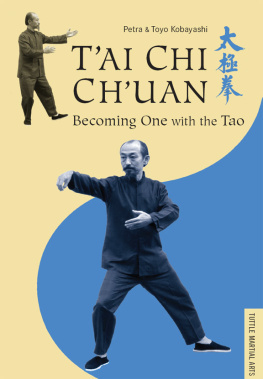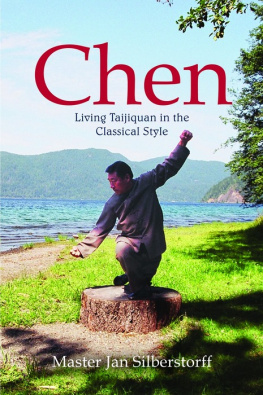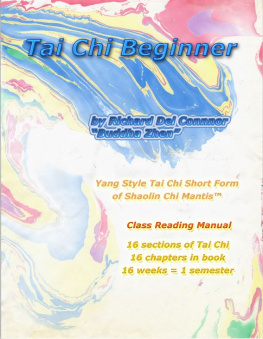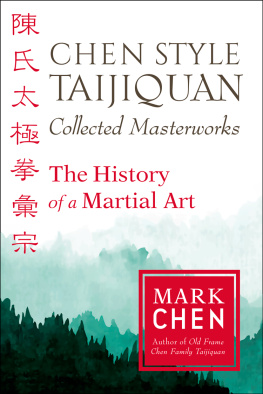
The Art of Taijiquan
An Examination of Five Family Styles
Copyright 2017 Andrew Townsend
All rights reserved. No part of this book may be reproduced by any means, graphic, electronic, or mechanical including photocopying, recording, taping, or by any information storage retrieval system without the express permission of the author except in the case of brief quotations embedded in critical articles or reviews.
ISBN-13: 978-1978071872
ISBN-10: 1978071876
For Grandmaster Dr. Jesse Tsao, whose knowledge, skill, wisdom, and generosity of spirit are the inspiration for this book.
Contents
Preface

This book is the result of the convergence of a number of influences on my life in general and my study of the martial art of taijiquan in particular. By both my natural disposition and by my undergraduate and graduate education, I consider myself to be a generalist. I like to look at individual trees and discern the forest. I enjoy observing the tiniest details in nature and relating them to generalized archetypes, such as watching a spider weaving its web and perceiving the similarity in its shape to that of a tightly wound spiral galaxy. As the ancient Taoist sages came to realize, from the observation and analysis of details general patterns emerge. The ability to make the intuitive leap from the specific to the general has always been one of my strengths and also a source of great personal satisfaction and wonderment. When I meet other like-minded individuals, I usually feel a deep sense of kinship and of shared respect.
Looking back now, some twenty-eight years later, I realize that all my early taijiquan teachers were specialists rather than generalists. When I began studying the art of taijiquan , I was fortunate to learn from several skilled Western teachers, each of whom had studied under one of Professor Zheng Manqings Chinese disciples. I later had the opportunity to meet and to attend workshops with some of Prof. Zhengs Chinese disciples: Abraham Liu, William C. C. Chen, and Ben Lo. Later, I had the opportunity to study for three months with Master James Huang in Honolulu, who had also studied with a disciple of Prof. Zheng in Taiwan.
Although these individuals were all skilled in Prof. Zhengs style of taijiquan and were each recognized as excellent pushing hands players, their perspective was limited to this one narrow branch of Yang style taijiquan . On my own initiative, I had made the effort to learn the Yang traditional long form. These teachers, however, each informed me that practicing the traditional long form was unnecessary, and that the thirty-seven movement Zheng Manqing form contained everything that was essential to the mastery taijiquan .
To be quite honest, in the first four years of my taijiquan journey, I really had no real awareness of the wider world of taijiquan . I now recognize that this was typical of many taijiquan enthusiasts who began studying this art in the United States at that time. Because Prof. Zheng Manqing had been one of the earliest Chinese masters of taijiquan to immigrate to the U.S. and to popularize this art, his influence and that of his disciples and their students dominated much of the taijiquan scene in this country for several decades.
At one point, I was studying in San Diego with a Westerner who was a direct student of Prof. Zheng. I considered this to have been a step up from studying with a student of a student of the Professor. A pushing hands friend told me about a Chinese teacher who had recently moved to San Diego and who was, to quote my friend, the real deal. He told me I had to check out this new teacher, but I felt that I had finally arrived by studying with this well-known Zheng Manqing representative.
Foolishly, I held out for several months before joining one of Master Jesse Tsaos classes at a local park. Upon meeting Master Tsao (who is now both a Grandmaster and holds a doctorate in Wushu from Shanghai Sport University), I immediately knew that I had, indeed, come upon the real deal in a taijiquan master. Not only was Grandmaster Tsaos skill of a caliber that I had never encountered, but his range of knowledge and mastery of the martial applications of taijiquan far surpassed any of the other teachers with whom I had previously studied.
When he came to the United States, Grandmaster Tsao had already studied taijiquan for many years and had achieved a level of mastery in the Chen, Yang, Wu, and Sun family styles of taijiquan that few individuals every attain. Moreover, he was able to convey to his students the general principles of taijiquan that transcended individual family styles. Here was another generalist someone whose skill I could marvel at, whose knowledge I could appreciate, and whose wisdom I could admire and aspire to.
Over the years since, my appreciation of Grandmaster Tsaos skill and knowledge have only grown as both he and I have evolved and progressed on our own individual taijiquan paths. I have continued to study with Master Jesse, as his students fondly refer to him, and count him among my closest friends. During the course of numerous weekend seminars and weeklong taijiquan summer camps, I have seen him switch effortlessly between different family styles, answering first a question on the traditional Yang style long form, next switch to the details of a complicated Wu style sword form technique, and then demonstrate the difference between the Chen style Old Frame Cannon Fist form and the New Frame version of this fast, explosive routine.
Not only does Grandmaster Tsao know the details of dozens of empty-hand and weapons forms, he is also able to demonstrate at speed the martial application(s) of every posture in each of these forms. His martial skill is remarkable and yet his personality is calm, gentle, kind, generous, and peaceful. He enjoins each of his indoor disciples in their initiation ceremony to refrain from employing taijiquan skill to injure others or to create discord within the larger taijiquan community.
In addition to his skill in both forms and martial applications, Grandmaster Tsao whole-heartedly espouses the practices of qigong , Traditional Chinese Medicine, and the concept of nourishing life ( yangsheng gong ). More than any other individual whom I have met in my long and eclectic taijiquan journey, Grandmaster Tsao embodies the essence of taijiquan as a primarily Taoist practice. This latter aspect of his personality is, perhaps for me, the most appealing and inspiring of all his many personal qualities. He is, for me, a true taijiquan generalist.
It is the model of a taijiquan generalist, represented in the person of Grandmaster Tsao, which served as the inspiration for this book. I already had studied the Chen, Yang, and Wu family styles with Grandmaster Tsao for many years. Several years ago, I made a promise to myself that I would extend my knowledge and understanding to include the Sun and Hao styles as well. Learning the Sun style was relatively easy, as I had Grandmaster Tsaos DVDs and his personal corrections to assist me. I also had access to Sun Lutangs manual and that of his daughter to provide me with technical details regarding the postures. I further knew several individuals who had learned this style and also Suns xingyiquan whose assistance proved invaluable.
The Hao style, however, was a greater challenge. I must admit that my practice of this style is based upon video sources only, although I was fortunate to obtain a copy of Danilo Marrones Hao Taijiquan Primer , which is based upon the writing of Hao Shao Ru and provided much valuable information and numerous insights into this relatively unknown style. In a way, learning the Hao style traditional long form was made easier by the fact that I had already learned the Sun style long form. Of course, this was actually working backward, as the Sun style is largely derived from the Hao style. In the end, although I am by no means an expert in this style, I believe that I was able to learn enough of the Hao style to at least be able to relate this style to the four other major family styles.
Next page







